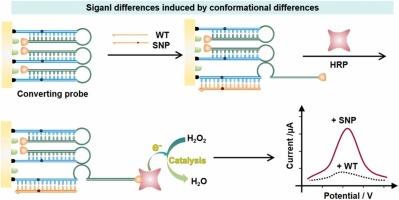Spatial repositioning enables an electrochemical platform for SNP sensing based on a conformationally-switchable hairpin probe
IF 3.7
1区 化学
Q1 CHEMISTRY, ANALYTICAL
引用次数: 0
Abstract
Accurate identification of single nucleotide polymorphisms (SNPs) holds significant importance for crop genetic improvement and precision breeding. However, traditional detection methods suffer from high costs, operational complexity, and heavy reliance on specialized equipment, limiting their large-scale application in breeding practices. Here, we present an electrochemical biosensing platform based on conformational change design, specifically tailored for sensitive and selective SNP analysis, achieved through the spatial reconfiguration of conformation-switchable hairpin probes. Upon hybridization with target sequences, the hairpin structure undergoes spatial remodeling to modulate its distance from the electrode surface, enabling signal transduction. This design leverages precise spatial control and structural dynamics to achieve high signal specificity, allowing single-base mismatch discrimination with exceptional reproducibility and sensitivity. The operationally simple biosensing platform demonstrates high specificity in distinguishing single-nucleotide variations. By applying this system to identify SNPs associated with key phenotypic traits related to leaf morphology in soybean genotypes, we validate its potential for genotype screening and molecular breeding applications.

空间重新定位使基于构象可切换发夹探针的SNP传感电化学平台成为可能
准确鉴定单核苷酸多态性(snp)对作物遗传改良和精准育种具有重要意义。然而,传统的检测方法存在成本高、操作复杂、严重依赖专用设备等问题,限制了其在养殖实践中的大规模应用。在这里,我们提出了一个基于构象变化设计的电化学生物传感平台,专门为敏感和选择性SNP分析量身定制,通过构象可切换发夹探针的空间重构实现。在与靶序列杂交后,发夹结构进行空间重塑以调节其与电极表面的距离,从而实现信号转导。这种设计利用精确的空间控制和结构动力学来实现高信号特异性,允许单碱基错配辨别具有卓越的再现性和灵敏度。操作简单的生物传感平台在区分单核苷酸变异方面表现出高特异性。通过应用该系统鉴定大豆基因型中与叶片形态相关的关键表型性状相关的snp,验证了该系统在基因型筛选和分子育种方面的应用潜力。
本文章由计算机程序翻译,如有差异,请以英文原文为准。
求助全文
约1分钟内获得全文
求助全文
来源期刊

Sensors and Actuators B: Chemical
工程技术-电化学
CiteScore
14.60
自引率
11.90%
发文量
1776
审稿时长
3.2 months
期刊介绍:
Sensors & Actuators, B: Chemical is an international journal focused on the research and development of chemical transducers. It covers chemical sensors and biosensors, chemical actuators, and analytical microsystems. The journal is interdisciplinary, aiming to publish original works showcasing substantial advancements beyond the current state of the art in these fields, with practical applicability to solving meaningful analytical problems. Review articles are accepted by invitation from an Editor of the journal.
 求助内容:
求助内容: 应助结果提醒方式:
应助结果提醒方式:


